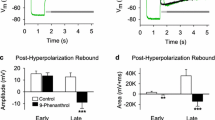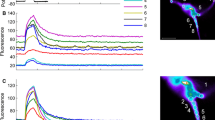Abstract
Calcium-activated potassium (KCa) channels contribute to multiple neuronal properties including spike frequency and afterhyperpolarizing potentials (AHPs). KCa channels are classified as KCa1.1, KCa2, or KCa3.1 based on single-channel conductance and pharmacology. Ca2+-dependent AHPs in vertebrates are categorized as fast, medium, or slow. Fast and medium AHPs are generated by KCa1.1 and KCa2 channels, respectively. The KCa subtype responsible for slow AHPs is unclear. Prolonged, Ca2+-dependent AHPs have been described in several leech neurons. Unfortunately, apamin and other KCa blockers often prove ineffective in the leech. An alternative approach is to utilize KCa modulators, which alter channel sensitivity to Ca2+. Vertebrate KCa2 channels are targeted selectively by the positive modulator CyPPA and the negative modulator NS8593. Here we show that AHPs in identified motor and mechanosensory leech neurons are enhanced by CyPPA and suppressed by NS8593. Our results indicate that KCa2 channels underlie prolonged AHPs in these neurons and suggest that KCa2 modulators may serve as effective tools to explore the role of KCa channels in leech physiology.







Similar content being viewed by others
Abbreviations
- AHP:
-
Afterhyperpolarization or afterhyperpolarizing potential
- BAPTA:
-
1,2-Bis(o-aminophenoxy)ethane-N,N,N′,N′-tetraacetic acid
- CyPPA:
-
Cyclohexyl-[2-(3,5-dimethylpyrazol-1-yl)-6-methylpyrimidin-4-yl]-amine
- DE-3:
-
Dorsal excitatory motor neuron 3
- HCN:
-
Hyperpolarization-activated and cyclic nucleotide-gated channels
- Ih :
-
Hyperpolarization-activated current
- KCa :
-
Calcium-activated potassium
- N cell:
-
Nociceptive mechanosensory neuron
- NS8593:
-
(R)-N-(benzimidazol-2-yl)-1,2,3,4-tetrahydro-1-naphthylamine
- P cell:
-
Pressure-sensitive mechanosensory neuron
- PIR:
-
Postinhibitory rebound
- SK:
-
Small conductance subtype of calcium-activated potassium channels
- T cell:
-
Touch-sensitive mechanosensory neuron
- V m :
-
Membrane potential
References
Adelman JP, Maylie J, Sah P (2012) Small-conductance Ca2+-activated K+ channels: form and function. Annu Rev Physiol 74:245–269
Andrade R, Foehring RC, Tzingounis AV (2012) The calcium-activated slow AHP: cutting through the Gordian knot. Front Cell Neurosci 6:47
Angstadt JD, Simone AM (2014) Riluzole suppresses postinhibitory rebound in an excitatory motor neuron of the medicinal leech. J Comp Physiol A 200:759–775
Angstadt JD, Grassmann JL, Theriault KM, Levasseur SM (2005) Mechanisms of postinhibitory rebound and its modulation by serotonin in excitatory swim motor neurons of the medicinal leech. J Comp Physiol A 191:715–732
Angstadt JD, Giordano JR, Goncalves AJ (2017) 9-phenanthrol modulates postinhibitory rebound and afterhyperpolarizing potentials in an excitatory motor neuron of the medicinal leech. J Comp Physiol A 203:613–633
Babenko VV, Podgorny OV, Manuvera VA, Kasianov AS, Manolov AI, Grafskaia EN, Shirokov DA, Kurdyumov AS, Vinogradov DV, Nikitina AS, Kovalchuk SI, Anikanov NA, Butenko IO, Pobeguts OV, Matyushkina DS, Rakitina DV, Kostryukova ES, Zgoda VG, Baskova IP, Vm T, Gelfand MS, Vm G, Schiöth HB, Lazarev VN (2020) Draft genome sequences of Hirudo medicinalis and salivary transcriptome of three closely related medicinal leeches. BMC Genom 21:331
Baylor DA, Nicholls JG (1969) After-effects of nerve impulses on signalling in the central nervous systems of the leech. J Physiol 203:571–589
Blackshaw SE (1981) Sensory cells and motor neurons. In: Nicholls JG, Muller KJ, Stent GS (eds) Neurobiology of the leech. Cold Spring Harbor, Cold Spring Harbor, pp 5l–78
Brown BM, Shim H, Christophersen P, Wulff H (2020) Pharmacology of small- and intermediate-conductance calcium-activated potassium channels. Annu Rev Pharmacol Toxicol 60:219–240
Burrell BD, Crisp KM (2008) Serotonergic modulation of afterhyperpolarization in a neuron that contributes to learning in the leech. J Neurophysiol 99:605–616
Cao YJ, Dreizler JC, Couey JJ, Houamed KM (2002) Modulation of recombinant and native neuronal SK channels by the neuroprotective drug riluzole. Eur J Pharm 449:47–54
Cataldo E, Brunelli M, Byrne JH, Av-Ron E, Cai Y, Baxter DA (2005) Computational model of touch sensory cells (T Cells) of the leech: role of the afterhyperpolarization (AHP) in activity-dependent conduction failure. J Comput Neurosci 18:5–24
Cho LT, Alexandrou AJ, Torella R, Knafels J, Hobbs J, Taylor T, Loucif A, Konopacka A, Bell S, Stevens EB, Pandit J, Horst R, Withka JM, Pryde DC, Liu S, Young GT (2018) An Intracellular allosteric modulator binding pocket in SK2 ion channels is shared by multiple chemotypes. Structure 26:533–544
Christophersen P, Wulff H (2015) Pharmacological gating modulation of small- and intermediate-conductance Ca2+-activated K+ channels (KCa2.x and KCa3.1). Channels 9:336–343
Eisenhart FJ, Cacciatore TW, Kristan WB (2000) A central pattern generator underlies crawling in the medicinal leech. J Comp Physiol A 186:631–643
El Manira A, Tegner J, Grillner S (1994) Calcium-dependent potassium channels play a critical role for burst termination in the locomotor network in lamprey. J Neurophysiol 72:1852–1861
Faber ESL, Sah P (2003) Calcium-activated potassium channels: multiple contributions to neuronal function. Neuroscientist 9:181–194
Gerard E, Hochstrate P, Dierkes P-W, Coulon P (2012) Functional properties and cell type specific distribution of Ih channels in leech neurons. J Exp Biol 215:227–238
Gu X (1991) Effect of conduction block at axon bifurcations on synaptic transmission to different postsynaptic neurones in the leech. J Physiol 441:755–778
Heyer CB, Lux HD (1976) Control of the delayed outward potassium current in bursting pace-maker neurones of the snail, Helix pomatia. J Physiol 262:349–382
Hille B (2001) Ion channels of excitable membranes, 3rd edn. Sinauer, Sunderland
Hodgkin AL, Huxley AF (1939) Action potentials recorded from inside a nerve fibre. Nature 144:710–711
Ishii TM, Maylie J, Adelman JP (1997) Determinants of apamin and d-tubocurarine block in SK potassium channels. J Biol Chem 272:23195–23200
Jansen JKS, Nicholls JG (1973) Conductance changes, an electrogenic pump and the hyperpolarization of leech neurones following impulses. J Physiol 229:635–655
Jenkins DP, Strøbæk D, Hougaard C, Jensen ML, Hummel R, Sørensen US, Christophersen P, Wulff H (2011) Negative gating modulation by (R)-N-(benzimidazol-2-yl)-1,2,3,4-tetrahydro-1-naphthylamine (NS8593) depends on residues in the inner pore vestibule: pharmacological evidence of deep-pore gating of KCa2 channels. Mol Pharmacol 79:899–990
Johansen J, Yang J, Kleinhaus AL (1987) Voltage-clamp analysis of the ionic conductances in a leech neuron with a purely calcium-dependent action potential. J Neurophysiol 58:1468–1484
Kristan WB Jr, Calabrese RL, Friesen WO (2005) Neuronal control of leech behavior. Prog Neurobiol 76:279–327
Kvist S, Manzano-Marín A, de Carle D, Trontelj P, Siddall ME (2020) Draft genome of the European medicinal leech Hirudo medicinalis (Annelida, Clitellata, Hirudiniformes) with emphasis on anticoagulants. Sci Rep 10:9885
Lamb DG, Calabrese RL (2013) Correlated conductance parameters in leech heart motor neurons contribute to motor pattern formation. PLoS ONE 8:e79267
Lamy C, Goodchild SJ, Weatherall KL, Jane DE, Liégeois J-F, Seutin V, Marrion NV (2010) Allosteric block of KCa2 channels by apamin. J Biol Chem 285:27067–27077
Littleton JT, Ganetzsky B (2000) Ion channels and synaptic organization: analysis of the Drosophila genome. Neuron 26:35–43
Mangan PS, Curran GA, Hurney CA, Friesen WO (1994) Modulation of swimming behavior in the medicinal leech. III. Control of cellular properties in motor neurons by serotonin. J Comp Physiol A 175:709–722
Mar A, Drapeau P (1996) Modulation of conduction block in leech mechanosensory neurons. J Neurosci 16:4335–4343
Meech RW, Standen NB (1975) Potassium activation in Helix aspersa neurones under voltage clamp: a component mediated by calcium influx. J Physiol 249:211–239
Merz DC (1995) Segmental specialization of calcium-activated potassium conductances in an identified neuron. J Neurophysiol 73:957–963
Nguyen L-T, Schmidt HA, von Haeseler A, Minh BQ (2015) IQ-TREE: a fast and effective stochastic algorithm for estimating maximum likelihood phylogenies. Mol Biol Evol 32:268–274
Nicholls JG, Baylor DA (1968) Specific modalities and receptive fields of sensory neurons in CNS of the leech. J Neurophyiol 31:740–756
Nolting A, Ferraro T, Dohoedt D, Stocker M (2007) An amino acid outside the pore region influences apamin sensitivity in small conductance Ca2+-activated K+ channels. J Biol Chem 282:3478–3486
Northcutt AJ, Fischer EK, Puhl JG, Mesce KA, Schulz DJ (2018) An annotated CNS transcriptome of the medicinal leech, Hirudo verbana: De novo sequencing to characterize genes associated with nervous system activity. PLoS ONE 13:e0201206
Omasits U, Ahrens CH, Müller S, Wollscheid B (2014) Bioinformatics 15:884–886. https://doi.org/10.1093/bioinformatics/btt607
Opdyke CA, Calabrese RL (1995) Outward currents in heart motor neurons of the medicinal leech. J Neurophysiol 74:2524–2537
Perez-Etchegoyen CB, Alvarez RJ, Rodriguez MJ, Szczupak L (2012) The activity of leech motoneurons during motor patterns is regulated by intrinsic properties and synaptic inputs. J Comp Physiol A 198:239–251
Peron S, Gabbiani F (2009) Spike frequency adaptation mediates looming stimulus selectivity in a collision-detecting neuron. Nat Neurosci 12:318–326
Poon M, Friesen WO, Stent GS (1978) Neural control of swimming in the medicinal leech. V. Connexions between the oscillatory interneurones and the motor neurones. J Exp Biol 75:45–63
Selverston AI (2010) Invertebrate central pattern generator circuits. Phil Trans R Soc B 365:2329–2345
Shah MM, Javadzadeh-Tabatabaie M, Benton DCH, Ganellin CR, Haylett DG (2006) Enhancement of hippocampal pyramidal cell excitability by the novel selective slow-afterhyperpolarization channel blocker 3-(triphenylmethylaminomethyl)pyridine (UCL2077). Mol Pharmacol 70:1494–1502
Stewart RR, Nicholls JG, Adams WB (1989) Na+, K+ and Ca2+ currents in identified leech neurones in culture. J Exp Biol 141:1–20
Stocker M, Hirzel K, D’hoedt D, Pedarzani P, (2004) Matching molecules to function: neuronal Ca2+-activated K+ channels and afterhyperpolarizations. Toxicon 43:933–949
Strøbæk D, Hougaar C, Johansen TH, Sørensen US, Nielsen EØ, Nielsen KS, Taylor RD, Pdarzani P, Christophersen P (2006) Inhibitory gating modulation of small conductance Ca2+-activated K+ channels by the synthetic compound (R)-N-(benzimidazol-2-yl)-1,2,3,4-tetrahydro-1-naphtylamine (NS8593) reduces afterhyperpolarizing current in hippocampal CA1 neurons. Mol Pharmacol 70:1771–1782
Vogalis F, Storm JF, Lancaster B (2003) SK channels and the varieties of slow after-hyperpolarizations in neurons. Eur J Neurosci 18:3155–3166
Weatherall KL, Seutin V, Liégeois J, Marrion NV (2011) Crucial role of a shared extracellular loop in apamin sensitivity and maintenance of pore shape of small conductance calcium-activated potassium (SK) channels. PNAS 108:18494–18499
Wei AD, Gutman GA, Aldrich R, Chandy KG, Grissmer S, Wulff H (2005) International Union of Pharmacology. LII. Nomenclature and molecular relationships of calcium-activated potassium channels. Pharmacol Rev 57:463–472
Wessel R, Kristan WB, Kleinfeld D (1999) Dendritic Ca2+-activated K+ conductances regulate electrical signal propagation in an invertebrate neuron. J Neurosci 19:8319–8326
Yang J, Johansen J, Koehm S, Kleinhaus AL (1987) In situ patch-clamp recording of calcium-activated potassium channels from an identified leech neuron. Brain Res 419:324–328
Yau KW (1976) Receptive fields, geometry and conduction block of sensory neurones in the central nervous system of the leech. J Physiol 263:513–538
Acknowledgements
The authors wish to thank David Weisblat, Tom Giarla, and Rachel Sterne-Marr for their insightful comments. All experiments are in accordance with current laws on animal experimentation and care in the USA.
Funding
This work was made possible by generous support from Siena College, including a CURCA summer research fellowship to Matthew I. Rebel.
Author information
Authors and Affiliations
Contributions
All authors contributed to data collection and analysis. The first draft of the manuscript was written by JDA and all authors commented on previous versions of the manuscript.
Corresponding author
Ethics declarations
Conflict of interest
The authors have no relevant financial or non-financial interests to disclose. The authors have no conflicts of interest to declare that are relevant to the content of this article. All authors certify that they have no affiliations with or involvement in any organization or entity with any financial interest or non-financial interest in the subject matter or materials discussed in this manuscript. The authors have no financial or proprietary interests in any material discussed in this article.
Ethics approval
No approvals required. The authors declare that experiments were conducted in compliance with current laws of the United States of America.
Consent for publication
All authors read and approved the final manuscript.
Availability of data and material
Available from first author upon request.
Additional information
Publisher's Note
Springer Nature remains neutral with regard to jurisdictional claims in published maps and institutional affiliations.
Supplementary Information
Below is the link to the electronic supplementary material.
Rights and permissions
About this article
Cite this article
Angstadt, J.D., Rebel, M.I. & Connolly, M.K. Effects of calcium-activated potassium channel modulators on afterhyperpolarizing potentials in identified motor and mechanosensory neurons of the medicinal leech. J Comp Physiol A 207, 69–85 (2021). https://doi.org/10.1007/s00359-021-01462-w
Received:
Revised:
Accepted:
Published:
Issue Date:
DOI: https://doi.org/10.1007/s00359-021-01462-w




